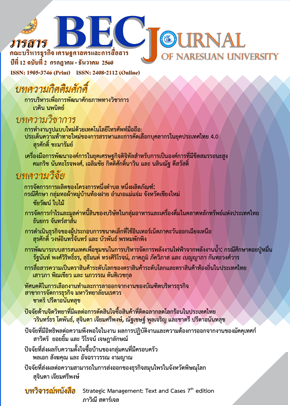การจัดการการผลิตของโครงการหนึ่งตำบล หนึ่งผลิตภัณฑ์: กรณีศึกษากลุ่มทอผ้าหมู่บ้านท้องฝาย อำเภอแม่แจ่ม จังหวัดเชียงใหม่
Main Article Content
บทคัดย่อ
วัตถุประสงค์หลักของงานวิจัยนี้คือ การศึกษาการจัดการการผลิตผ้าทอของกลุ่มทอผ้าบ้านท้องฝาย อำเภอแม่แจ่ม จังหวัดเชียงใหม่ ผ้าทอเป็นผลิตภัณฑ์ของโครงการหนึ่งตำบล หนึ่งผลิตภัณฑ์ที่มีชื่อเสียงมากที่สุดอย่างหนึ่งของจังหวัดเชียงใหม่ และศิลปะการถักทอแบบดั้งเดิมถือเป็นภูมิปัญญาท้องถิ่นที่มีคุณค่าสมควรแก่ การอนุรักษ์ไว้ แต่ปัจจุบันสภาพแวดล้อมในการดำเนินธุรกิจเปลี่ยนแปลงไปอย่างรวดเร็ว ส่งผลให้ผู้ประกอบการส่วนใหญ่รวมถึงกลุ่มทอผ้าของหมู่บ้านท้องฝายต้องมีการปรับเปลี่ยนการดำเนินงานของกลุ่มให้สอดรับกับการเปลี่ยนแปลงที่เกิดขึ้นด้วย จากการสัมภาษณ์เชิงลึกกับผู้นำชุมชนและผู้ประกอบการในพื้นที่พบว่า ปัญหาที่สำคัญเกี่ยวกับการจัดการการผลิตที่ควรแก้ไขคือ การปรับปรุงผลิตภัณฑ์บางชนิดให้ทันสมัย และการวางผังการผลิตใหม่ให้มีประสิทธิภาพมากยิ่งขึ้น ซึ่งข้อค้นพบหลักทั้ง 2 ประเด็นสอดคล้องกับผลงานวิจัยที่ผ่านมา อย่างไรก็ตาม ข้อค้นพบหนึ่งของการศึกษานี้ที่แตกต่างกับงานวิจัยก่อนหน้าคือ เครื่องจักรที่ทันสมัยในอุตสาหกรรมทอผ้า ไม่สามารถทดแทนภูมิปัญญาชาวบ้านได้อย่างสมบูรณ์ จากการวิเคราะห์การวางผังการผลิตของผลิตภัณฑ์ที่ขายดี ได้แก่ กระเป๋าถือลายจกทอมือย้อมสีธรรมชาติพบว่า กลุ่มทอผ้าควรปรับเปลี่ยนการวางผังใหม่ โดยใช้หลักจัดเวลามากที่สุดเข้าก่อน เนื่องจากการวางผังด้วยวิธีนี้ทำให้เกิดประสิทธิภาพสูงที่สุด
Article Details
เอกสารอ้างอิง
2. Bertalanffy, L. V. (1950). An outline of general system theory. British Journal for the Philosophy of Science, 1(2), 134-165.
3. Boondao, R. (2016). Management information systems in the digital era. Nonthaburi: Lucky Book.
4. Chancharoen, P. and Chanvichai, K. (2016). An integrated marketing communications strategies for marketing promotion in international education agencies in Chiang Mai province. Journal of Business, Economics and Communications, 11(Special), 73-86.
5. Chiarakul, T. (2014). The problems and the adaptation of OTOP to AEC. Executive Journal, 34, 177-191.
6. Chokbandansuk, W., Anuloke, K. and Thongprayoon, W. (2016). Local wisdom inheritance of Teen Chok Tai-Yuan fabric production in Ratchaburi Province. Journal of the Association of Researchers, 21(1), 166-180.
7. Cresswell, J. W. (2013). Research design: qualitative, quantitative and mixed methods approaches (2nd ed.). Thousand Oaks, CA: Sage Publication.
8. Drucker, P. (1993). Management: tasks, responsibilities, practices. New York: Harper and Row.
9. Heizer, J., Render, B. and Munson, C. (2016). Operations management. Boston: Pearson.
10. Helms, M. M. and Nixon, J. (2010). Exploring SWOT analysis-where are we now?: A review of academic research from the last decade. Journal of Strategy and Management, 3(3), 215-251.
11. Jittimongkhon, S. and Jittimongkon, S. (2016). Foundations of economics. Bangkok: Mac Education.
12. Jundaeng, K. (2006). Production and operations management. Bangkok: Witty Group.
13. Kabbour, P. (2015). Marketing principle. Chiang Mai: Faculty of Management Sciences, Chiangmai Rajabhat University.
14. Kachornkittiya, N., Esor, U., Juntharattana, R., Wutthiwong, V. and Narkrueng, D. (2016). Corporate sustainability under the sufficiency economy of One Tambon One Product enterprise in the three southern border provinces. Journal of Business, Economics and Communications, 11(1), 98-112.
15. Khwanngern, S. (2006). Production and operations management. Bangkok: SE-ED.
16. Kotler, P. (2000). Marketing management: analyzing consumer marketing and buyer behavior (The Millennium). New Jersey: Prentice Hall.
17. Laosiritaworn, W. (2009). Operations management. Chiang Mai: S.T. Film and Plate.
18. Malasitt, S. (2005). Production and operations management. Bangkok: Samrada.
19. Nathalang, E., Eawsriwong, N., Panich, W., Tosittakul, R. and Chompoonuch, N. (2003). Local wisdom and knowledge management. Bangkok: Amarin.
20. Parasuraman, A., Zeithaml, V. A. and Berry, L. L. (1988). SERVQUAL: A multiple-item scale for measuring consumer perceptions of service quality. Journal of Retailing, 64(1), 12-40.
21. Ploymeka, C. (1980). Production management. Bangkok: SE-ED.
22. Santiwong, T. (2002). Management. Bangkok: Chulalongkorn University Press.
23. Sarungkarasiri, C. (2002). Production control and planning. Bangkok: Technology Promotion Association (Thailand-Japan).
24. Serirat, S., Hirankiti, S., Suwannapirom, S., Sriwarom, R. and Prapawanon, C. (2002). Organization and Management. Bangkok: Pattanasuksa.
25. Serirat, S., Raksitanon, P., Serirat, S. and Patawanich, O. (1998). Marketng strategies, marketing management, and case studies. Bangkok: Teera Film and Sitex.
26. Sirikrai, S. (2016). Operations Management in the business world. Bangkok: SE-ED.
27. Somrit, S. and Intakan, P. (2012). Manageming cost and return for Thai-Lue textile products in Chiang Kham, Phayao. Modern Management Journal, 5(1), 116-125.
28. Srisuwan, T. (1996). Management in the 21st Century. Bangkok: Main Manage.
29. The Central Information Systems, Ministry of Interior. (2016). Total revenue of OTOP in Fiscal year 2016 (From October 2015 to September 2016). Retrieved September, 14 2016, from http://203.114.112.233/CDDCENTER/cdd_report/otop_r04.php?&year=2559&org_group=0
30. Thianthai, C. (2004). Management: executive viewpoint. Bangkok: Top.
31. Tiangkate, N., Jakthip, W. and Intaphan, B. (2007). Weaving class: the inheritance knowledge of Mae Cham’s weaving. Chiang Mai: Ko-Kayan.
32. Vargo, S. L. and Lusch, R. F. (2004). Evolving to a new dominant logic for marketing. Journal of Marketing, 68(1), 1-17.
33. Watcharanulak, A. (2009). An application of lean system to garment manufaturing: polo shirt production line. Master Thesis, M.Eng, Rajamangala University of Technology, Pathumthani.


